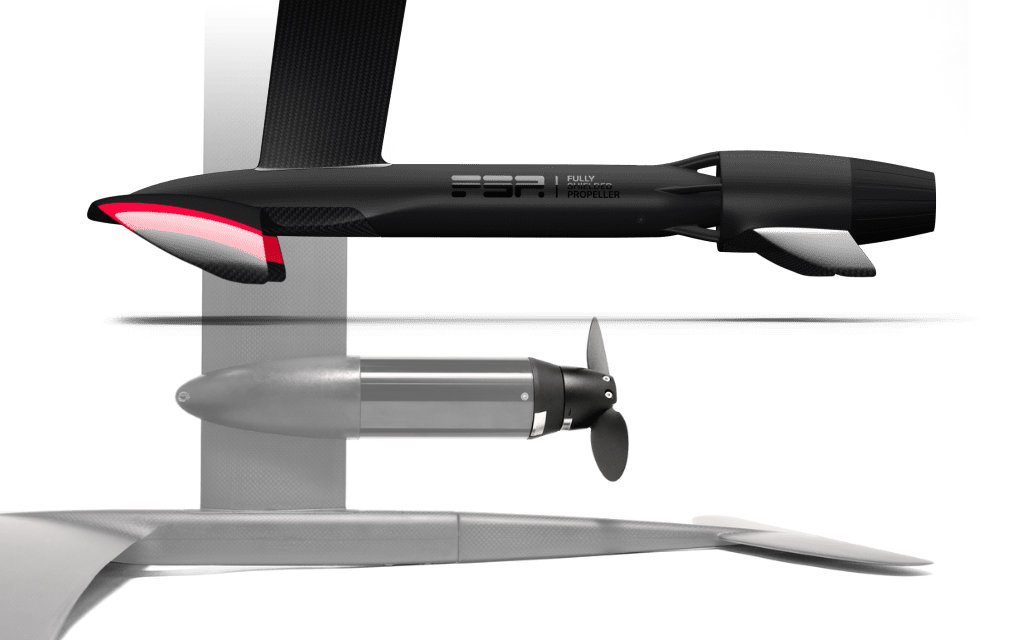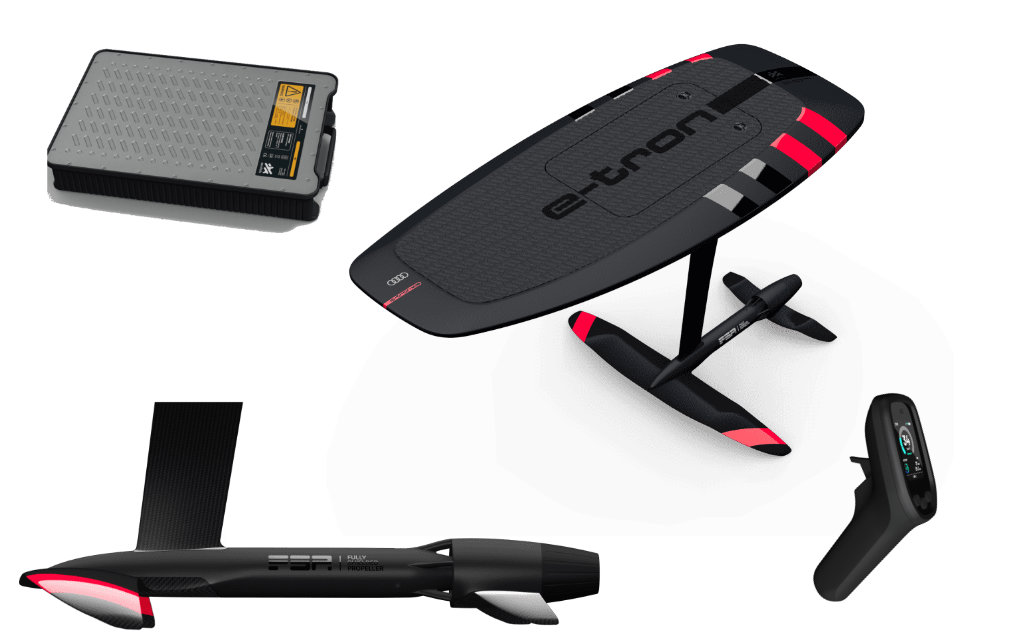How does an eFoil work: Easy-to-understand explanation of eFoil technology. Propeller vs. jet, battery range, setups for beginners and pros.
In short: An eFoil is an electrically powered hydrofoil surfboard. An underwater wing generates lift, the hull lifts out of the water, an electric motor provides thrust, you control the speed with a handheld remote control, and you control the height by shifting your weight.
What is an eFoil?
An eFoil is a surfboard with a mast, hull (fuselage), front wing, and rear wing. The drive is located in the mast base. Energy comes from a waterproof encapsulated lithium-ion battery in the board. The system is controlled with a wireless remote control in your hand.
Well-known manufacturers include Fliteboard from Australia, Lift Foils from Puerto Rico/USA, and Aerofoils with the Audi e-tron Foil from Germany. All offer modular systems with different boards, masts, wings, batteries, and a choice of propeller or jet drives.
We made the following video on the topic of “How does an eFoil work” for the E-SURFER YouTube channel:
This is how “flight” over water is achieved
One of the most important aspects of how an eFoil works is the wings. The front wing works like an aircraft wing in water. As speed increases, higher pressure builds up under the wing and lower pressure above it. This creates lift. At a certain speed, the eFoil lifts out of the water. Friction decreases and the board glides efficiently and smoothly. Physically, this is based on fluid dynamics and the Bernoulli principle.
You don't control the height by “accelerating.” You control it by shifting your weight: leaning forward lowers the nose (and thus the angle of the underwater wing, which is rigidly connected to the board), leaning backward raises the tip of the board. The throttle is primarily used to maintain the appropriate cruising speed. This separation makes riding controllable and stable.
The main components at a glance
- Board: Volume determines stability. Large is forgiving, small is sporty.
- Mast: Connects the board and wing. Length influences the “flight height” above the water.
- Front wing: Provides lift and character. Large, thick wings take off early and are stable. Small wings are fast and responsive.
- Stabilizer (rear wing): Dampens and stabilizes.
- Drive unit: Motor, propeller/jet, and electronics are located in the mast. The electronics are at the top and the motor/drive is at the bottom in the fuselage area.
- Battery: Supplies everything with power.
- Handheld remote control: Trigger for thrust, display for driving data.

How does an eFoil work – propeller vs. jet:
The propeller was the standard for many years. It is efficient, very direct, and economical at low loads. Disadvantage: Open propellers pose a risk of injury. Protective cages reduce the risk, but increase drag. Accidents involving propellers are quite rare, but when they do happen, they are not pretty. Very athletic riders, especially those who want to ride waves of one meter or higher without motor power, still prefer the propeller—without protection as a folding propeller variant.
Jet drives (shielded impeller) have been gaining popularity since 2022. They run quietly, feel smooth, and are considered safer due to the completely enclosed impeller geometry. Manufacturers such as Aerofoils (the pioneer of the jet in eFoils), Fliteboard, and Lift offer jet options. The jet is a must for beginners and schools, but has now also become the first choice for “normal eFoiler” users. Why take the risk of serious injury with a propeller when the jet has sufficient power? And you can also ride waves with it thanks to the lower water resistance.
Practical conclusion:
- Safety: Advantage jet.
- Efficiency/top speed: Slight advantage propeller.
- Feeling: Jet = smooth and quiet, prop = direct punch.
An eFoil works at least as well with a jet as with a propeller. Only it is much safer.
Battery, range, and charging times
Like an electric car, an eFoil runs on a lithium-ion battery. The realistic driving time is usually between 60 and 90 minutes, depending on rider weight, wing setup, speed, water temperature, and wave conditions. Large batteries run for about 2–2.5 hours under optimal conditions, while lighter batteries tend to run for 45 minutes. Fast riding quickly halves the time. Cruising extends it.
Examples from the market:
- Fliteboard “Flitecell Sport” up to ~1.5 hours, ‘Explore’ up to ~2.5 hours.
- Lift Foils claims ~90 minutes “on power” with the large battery and offers a jet option.
- Aerofoils claims up to 2 hours under ideal conditions.
Charging: Depending on the system, between a good 90 minutes (premium charger) and several hours (large battery, standard charger). Manufacturer specifications vary. A standard value of “approx. 1–2 hours” is a solid estimate; local networks and chargers determine the rest.
How does an eFoil remote control work?
The trigger controls the thrust in fine increments on the remote control, also known as a hand controller. Modern remotes have large color displays and show speed, battery level, driving programs, and sometimes telemetry.
Important: Do not control altitude with the throttle. Find a steady cruising speed and then work exclusively with weight and clean edge changes. This makes foiling controllable and saves energy.
Setup for beginners: board, wing, mast
- Board size: Start with more volume. Standing up and starting off will be more stable.
- Front wing: A larger wing (e.g., 1500–2000 cm² for all-round systems) helps with early takeoff and smooth cruising.
- Mast length: Medium (e.g., ~70–80 cm) is universal.
- Drive: Jet reduces stress when learning and increases safety
- Battery: Only the large batteries are sufficient for sessions of 60–90 minutes. Smaller batteries are for riding the waves without motor power.
You can get complete purchasing advice from us in our shop, by email, or by phone. You can find out more in advance on our eFoil purchasing advice page.
How does an eFoil work: Safety
- Protective equipment: Helmet, impact protection, leash (in strong winds or waves), suitable wetsuit.
- Spot selection: Open water, away from swimming areas and boats.
- Propulsion: Jet reduces the risk of injury in the vicinity of the rotor. Never start the propeller in shallow waterand always treat it with respect.
- Battery handling: Only use the original charger. Keep contacts dry and clean. Do not tolerate any mechanical damage. Follow the instructions in the respective manual.

Care, transport, and maintenance
Always rinse with fresh water after saltwater use. Check corrosion protection on metal connections. Keep plug connections dry. Clean and grease the battery compartment seals if necessary.
Tighten screws to the correct torque. Use board bags or eFoil carts for transport, protect wing edges.
These standards are laid down in the manufacturer's documentation and significantly extend the service life.
Frequently asked questions (FAQ)
How fast does an eFoil go?
Anything is possible, from leisurely cruising at 20–30 km/h to speeds of up to 50 km/h, depending on the wing, board, rider (weight), and drive. Manufacturers such as Aerofoils quote top speeds of around 50 km/h and more with special race wings. The ideal is continuous cruising at 20–30 km/h, which is efficient and smooth.
Which is better for beginners: propeller or jet?
Jet. The safety advantage and smooth response outweigh the slight efficiency disadvantages. Schools should only use a jet. Anything else would be irresponsible. Keep this in mind during your first eFoil lesson.
How long does the battery really last?
Plan on 60–90 minutes. With a large battery, smooth riding, and the right setup, you can get up to about 2 hours or more. High speed, cold water, and frequent touch-downs significantly reduce battery life.
How heavy is an eFoil?
Complete with battery, 25–35 kg is typical, depending on board material, battery, and drive. Manufacturers' websites list the individual weights; check the specifications of your specific setup before purchasing.
Do I need any special prior knowledge?
No. Anyone with a little sense of balance can learn quickly. Beginners often ride standing up after a short introduction. Good instruction shortens the learning curve.
How much does an eFoil cost?
Premium sets are in the five-figure range. Differences arise from the material, battery capacity, and accessories. Check whether the jet, quick charger, and a good remote control are included.
How does an eFoil work – conclusion
An eFoil combines classic fluid dynamics with modern e-mobility. The wing provides lift, the motor provides thrust.
Your hands control the power, your body controls the height. Jet drives increase safety. Realistic riding times are 1–1.5 hours, longer with a large battery.
Those who learn in a structured way ride quickly, cleanly, and smoothly. After that, all that matters is finding the right combination of board, wing, battery, and drive for your own purposes.


 11 min read
11 min read